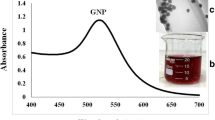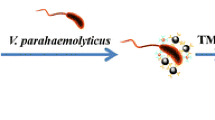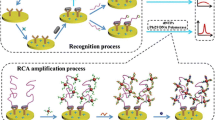Abstract
Over the last decade, isolation and purification of monoclonal antibodies, for diagnostic analysis, have been carried out using the hybridoma expression system. The present study describes a novel example of a detection system using hybridoma cells containing antibody against O1 antigen directly for V. cholerae diagnosis, which is a major health problem in many parts of the world, especially in developing countries. This method has advantages such as simplicity, ease of process, and it does not require manipulation of hybridoma cell. For this approach, an efficient amount of fluorescence calcium indicator, fura 2-AM, was utilized, which emitted light when the intracellular calcium concentration increased as result of antigen binding to specific antibody. More reliable results are obtained via this method and it is considerably faster than other methods, which has the response time of less than 45 s for detection of V. Cholerae O1. Also, the limit of detection was computed to be 50 CFU/mL (<13 CFU per assay). In addition, no significant responses were observed in the presence of other bacteria with specific hybridoma or other cell lines exposed to V. cholerae O1. Furthermore, this method was successfully applied to V. cholerae O1 detection in spiked environmental samples, including water and stool samples without any pretreatment. All results reveal that hybridoma cells can provide a valuable, simple, and ready to use tool for rapid detection of other pathogenic bacteria, toxins, and analytes.







Similar content being viewed by others
References
Maragos CM. Recent advances in the development of novel materials for mycotoxin analysis. Anal Bioanal Chem. 2009;395(5):1205–13.
Pandey S. Hybridoma technology for production of monoclonal antibodies. Hybridoma. 2010;1(2):017.
Kramer K, Hock B. Recombinant antibodies for environmental analysis. Anal Bioanal Chem. 2003;377(3):417–26.
Milstein C. The hybridoma revolution: an offshoot of basic research. Bioessays. 1999;21(11):966–73.
Zamani P, Sajedi RH, Hosseinkhani S, Zeinoddini M, Bakhshi B. A luminescent hybridoma-based biosensor for rapid detection of V. cholerae upon induction of calcium signaling pathway. Biosens Bioelectron. 2016;79:213–9.
Petrovick MS, Harper JD, Nargi FE, Schwoebel ED, Hennessy MC, Rider TH, Hollis MA. Rapid sensors for biological-agent identification. Lincoln Lab J. 2007;17(1):63–84.
Rider TH, Petrovick MS, Nargi FE, Harper JD, Schwoebel ED, Mathews RH, Blanchard DJ, Bortolin LT, Young AM, Chen J. AB cell-based sensor for rapid identification of pathogens. Science. 2003;301(5630):213–5.
Wilson HA, Greenblatt D, Poenie M, Finkelman F, Tsien R. Crosslinkage of B lymphocyte surface immunoglobulin by anti-Ig or antigen induces prolonged oscillation of intracellular ionized calcium. J Exp Med. 1987;166(2):601–6.
Takahashi N, Nemoto T, Kimura R, Tachikawa A, Miwa A, Okado H, Miyashita Y, Iino M, Kadowaki T, Kasai H. Two-photon excitation imaging of pancreatic islets with various fluorescent probes. Diabetes. 2002;51 Suppl 1:S25–8.
Regehr W, Tank D. Selective fura-2 loading of presynaptic terminals and nerve cell processes by local perfusion in mammalian brain slice. J Neurosci Methods. 1991;37(2):111–9.
Wang L, Wang R, Kong B-W, Jin S, Ye K, Fang W, Li Y. B cells using calcium signaling for specific and rapid detection of Escherichia coli O157: H7. Scientific reports. 5;2015:10598.
Robb M, Nichols JC, Whoriskey SK, Murphy JR. Isolation of hybridoma cell lines and characterization of monoclonal antibodies against cholera enterotoxin and its subunits. Infect Immun. 1982;38(1):267–72.
Colwell RR, Kaper J, Joseph SW. Vibrio cholerae, Vibrio parahaemolyticus, and other vibrios: occurrence and distribution in Chesapeake Bay. Science. 1977;198(4315):394–6.
Islam MS, Drasar BS, Sack RB. The aquatic flora and fauna as reservoirs of Vibrio cholerae: a review. J Diarrhoeal Dis Res. 1994;87–96.
Gubala AJ. Multiplex real-time PCR detection of Vibrio cholerae. J Microbiol Methods. 2006;65(2):278–93.
Kay BA, Bopp CA, Wells JG. Isolation and identification of Vibrio cholerae O1 from fecal specimens. Vibrio cholerae and cholera: molecular to global perspectives. Washington: ASM Press; 1994. p. 3–25.
Indrawattana N, Promptmas C, Wat-Aksorn K, Soontornchai S. Real-time monitoring of DNA hybridization for rapid detection of Vibrio cholerae O1. Anal Methods. 2014;6(19):7634–9.
Khemthongcharoen N, Wonglumsom W, Suppat A, Jaruwongrungsee K, Tuantranont A, Promptmas C. Piezoresistive microcantilever-based DNA sensor for sensitive detection of pathogenic Vibrio cholerae O1 in food sample. Biosens Bioelectron. 2015;63:347–53.
Yamazaki W, Seto K, Taguchi M, Ishibashi M, Inoue K. Sensitive and rapid detection of cholera toxin-producing Vibrio cholerae using a loop-mediated isothermal amplification. BMC Microbiol. 2008;8(1):94.
Adams LB, Henk MC, Siebeling RJ. Detection of Vibrio cholerae with monoclonal antibodies specific for serovar O1 lipopolysaccharide. J Clin Microbiol. 1988;26(9):1801–9.
Hasan JAK, Bernstein D, Huq A, Loomis L, Tamplin ML, Colwell RR. Cholera DFA: an improved direct fluorescent monoclonal antibody staining kit for rapid detection and enumeration of Vibrio cholerae O1. FEMS Microbiol Lett. 1994;120(1/2):143–8.
Wang D, Xu X, Deng X, Chen C, Li B, Tan H, Wang H, Tang S, Qiu H, Chen J. Detection of Vibrio cholerae O1 and O139 in environmental water samples by an immunofluorescent-aggregation assay. Appl Environ Microbiol. 2010;76(16):5520–5.
Heidelberg J, Heidelberg K, Colwell R. Bacteria of the γ-subclass proteobacteria associated with zooplankton in Chesapeake Bay. Appl Environ Microbiol. 2002;68(11):5498–507.
Alam M, Sultana M, Nair GB, Sack RB, Sack DA, Siddique A, Ali A, Huq A, Colwell RR. Toxigenic Vibrio cholerae in the aquatic environment of Mathbaria, Bangladesh. Appl Environ Microbiol. 2006;72(4):2849–55.
Schauer S, Sommer R, Farnleitner AH, Kirschner AK. Rapid and sensitive quantification of Vibrio cholerae and Vibrio mimicus cells in water samples by use of catalyzed reporter deposition fluorescence in situ hybridization combined with solid-phase cytometry. Appl Environ Microbiol. 2012;78(20):7369–75.
Chakraborty S, Alam M, Scobie HM, Sack DA. Adaptation of a simple dipstick test for detection of Vibrio cholerae O1 and O139 in environmental water. Front Microbiol. 2013;4:320.
George CM, Rashid M-U, Sack DA, Bradley Sack R, Saif-Ur-Rahman KM, Azman AS, Monira S, Bhuyian SI, Zillur Rahman KM, Toslim Mahmud M. Evaluation of enrichment method for the detection of Vibrio cholerae O1 using a rapid dipstick test in Bangladesh. Tropical Med Int Health. 2014;19(3):301–7.
Nato F, Boutonnier A, Rajerison M, Grosjean P, Dartevelle S, Guenole A, Bhuiyan NA, Sack DA, Nair GB, Fournier JM. One-step immunochromatographic dipstick tests for rapid detection of Vibrio cholerae O1 and O139 in stool samples. Clin Diagn Lab Immunol. 2003;10(3):476–8.
Thiramanas R, Jangpatarapongsa K, Tangboriboonrat P, Polpanich D. Detection of Vibrio cholerae using the intrinsic catalytic activity of a magnetic polymeric nanoparticle. Anal Chem. 2013;85(12):5996–6002.
Sharma A, Baral D, Rawat K, Solanki PR, Bohidar HB. Biocompatible capped iron oxide nanoparticles for Vibrio cholerae detection. Nanotechnology. 2015;26(17):175302.
Barzamini B, Moghbeli M, Soleimani NA. Vibrio cholerae detection in water and wastewater by polymerase chain reaction assay. Int J Enteric Pathog. 2014;2(4):e20997.
Yadava JP, Jain M, Goel AK. Detection and confirmation of toxigenic Vibrio cholerae O1 in environmental and clinical samples by a direct cell multiplex PCR. Water SA. 2013;39(5):611–4.
Alam M, Sultana M, Nair GB, Siddique A, Hasan NA, Sack RB, Sack DA, Ahmed KU, Sadique A, Watanabe H, Grim CJ, Huq A, Colwell RR. Viable but nonculturable Vibrio cholerae O1 in biofilms in the aquatic environment and their role in cholera transmission. Proc Natl Acad Sci. 2007;104(45):17801–6.
Leal N, Sobreira M, Leal‐Balbino T, Almeida A, Silva M, Mello D, Seki LM, Hofer E. Evaluation of a RAPD‐based typing scheme in a molecular epidemiology study of Vibrio cholerae O1, Brazil. J Appl Microbiol. 2004;96(3):447–54.
Di Pinto A, Ciccarese G, Tantillo G, Catalano D, Forte VT. A collagenase-targeted multiplex PCR assay for identification of Vibrio alginolyticus, Vibrio cholerae, and Vibrio parahaemolyticus. J Food Prot. 2005;68(1):150–3.
Boyd EF, Moyer KE, Shi L, Waldor MK. Infectious CTXΦ and the vibrio pathogenicity island prophage in Vibrio mimicus: evidence for recent horizontal transfer between V. mimicus and V. cholerae. Infect Immun. 2000;68(3):1507–13.
Choopun N, Louis VR, Huq A, Colwell RR. Simple procedure for rapid identification of Vibrio cholerae from the aquatic environment. Appl Environ Microbiol. 2002;68(2):995–8.
Nhung PH, Ohkusu K, Miyasaka J, Sun XS, Ezaki T. Rapid and specific identification of 5 human pathogenic Vibrio species by multiplex polymerase chain reaction targeted to dnaJ gene. Diagn Microbiol Infect Dis. 2007;59(3):271–5.
O'Hara CM, Sowers EG, Bopp CA, Duda SB, Strockbine NA. Accuracy of six commercially available systems for identification of members of the family Vibrionaceae. J Clin Microbiol. 2003;41(12):5654–9.
Panicker G, Myers ML, Bej AK. Rapid detection of Vibrio vulnificus in shellfish and Gulf of Mexico water by real-time PCR. Appl Environ Microbiol. 2004;70(1):498–507.
Senachai P, Chomvarin C, Namwat W, Wongboot W, Wongwajana S, Tangkanakul W. Application of tetraplex PCR for detection of Vibrio cholerae, V. parahaemolyticus, V. vulnificus, and V. mimicus in cockle. SE Asian J Trop Med Public Health. 2013;44:249–58.
Zeinoddini M, Saeedinia AR, Sadeghi V. Rapid detection of Vibrio cholerae using hexaplex PCR assay. J Police Med. 2014;3(2):78–84.
Sungkanak U, Sappat A, Wisitsoraat A, Promptmas C, Tuantranont A. Ultrasensitive detection of Vibrio cholerae O1 using microcantilever-based biosensor with dynamic force microscopy. Biosens Bioelectron. 2010;26(2):784–9.
Lipp EK, Rivera ING, Gil AI, Espeland EM, Choopun N, Louis VR, Russek-Cohen E, Huq A, Colwell RR. Direct detection of Vibrio cholerae and ctxA in Peruvian coastal water and plankton by PCR. Appl Environ Microbiol. 2003;69(6):3676–80.
Rivera ING, Chun J, Huq A, Sack RB, Colwell RR. Genotypes associated with virulence in environmental isolates of Vibrio cholerae. Appl Environ Microbiol. 2001;67(6):2421–9.
Mukherjee P, Ghosh S, Ramamurthy T, Bhattacharya MK, Nandy RK, Takeda Y, Nair GB, Mukhopadhyay AK. Evaluation of a rapid immunochromatographic dipstick kit for diagnosis of cholera emphasizes its outbreak utility. Jap J Infect Dis. 2010;63(4):234–8.
Acknowledgments
This work was supported by the research council of Tarbiat Modares University and Ministry of Sciences, Researches, and Technology, Iran.
Author information
Authors and Affiliations
Corresponding author
Ethics declarations
Conflict of interest
The authors declare that they have no conflict of interest.
Rights and permissions
About this article
Cite this article
Zamani, P., Sajedi, R.H., Hosseinkhani, S. et al. Hybridoma as a specific, sensitive, and ready to use sensing element: a rapid fluorescence assay for detection of Vibrio cholerae O1. Anal Bioanal Chem 408, 6443–6451 (2016). https://doi.org/10.1007/s00216-016-9762-y
Received:
Revised:
Accepted:
Published:
Issue Date:
DOI: https://doi.org/10.1007/s00216-016-9762-y




